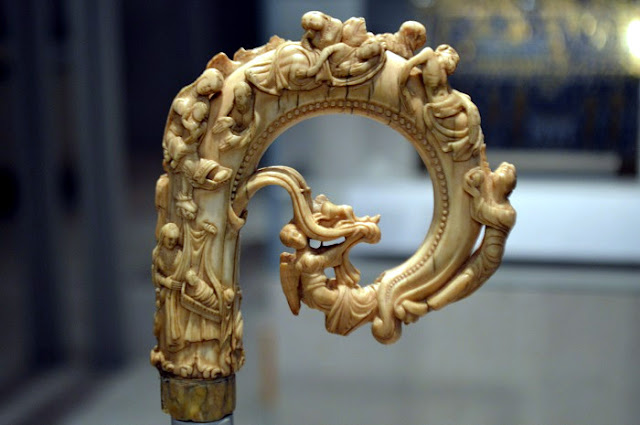The St Nicholas Crozier
<
Table of Contents
I’ve mentioned before that I have a strange fascination for ivory, but I also appear to have something similar for historical croziers. I think that the appeal has much to do with the dichotomy between them once having been potent symbols of enduring power and the fact that they’re now frequently seen in museum cabinets … or, at least, that’s where I usually encounter them, not regularly hanging out amongst those with episcopal leanings. This particular example has some exquisite carving, depicting scenes from the nativity and the annunciation, along with a number of scenes related to the life of St Nicholas, Bishop of Myra. One of these represents Nicholas’ famous gifts of gold to three daughters of a poor family. The money was necessary to pay for the young women’s dowries, without which they would have no other option than to take to the streets as ‘ladies of negotiable virtue’. Years ago, when I first encountered this myth, I was intrigued that the story had inspired the pawnbroker’s symbol of the three golden balls. Coming back to it now, I’m more suspicious of a worldview (and an organised religion) that can only regard adult women as either marriageable opportunities or prostitutes. The third St Nicholas-related scene relates to the legend that, even as a babe-in-arms, he was so pious that he refused breastmilk on Wednesdays and Fridays until evening prayers had finished. It seems like the type of nonsense that only people who did not have children of their own could either make up or believe.
I’ve mentioned before that I have a strange fascination for ivory, but I also appear to have something similar for historical croziers. I think that the appeal has much to do with the dichotomy between them once having been potent symbols of enduring power and the fact that they’re now frequently seen in museum cabinets … or, at least, that’s where I usually encounter them, not regularly hanging out amongst those with episcopal leanings. This particular example has some exquisite carving, depicting scenes from the nativity and the annunciation, along with a number of scenes related to the life of St Nicholas, Bishop of Myra. One of these represents Nicholas’ famous gifts of gold to three daughters of a poor family. The money was necessary to pay for the young women’s dowries, without which they would have no other option than to take to the streets as ‘ladies of negotiable virtue’. Years ago, when I first encountered this myth, I was intrigued that the story had inspired the pawnbroker’s symbol of the three golden balls. Coming back to it now, I’m more suspicious of a worldview (and an organised religion) that can only regard adult women as either marriageable opportunities or prostitutes. The third St Nicholas-related scene relates to the legend that, even as a babe-in-arms, he was so pious that he refused breastmilk on Wednesdays and Fridays until evening prayers had finished. It seems like the type of nonsense that only people who did not have children of their own could either make up or believe.
Whatever we make of the
scenes depicted, the fact remains that this is a simply exquisite piece and
justifiably described in the V&A’s online catalogue as ‘one of the most
sublime achievements of the medieval ivory carver's art’. It is thought to have
been made between 1150 and 1170, either in France or England.






Comments
Post a Comment